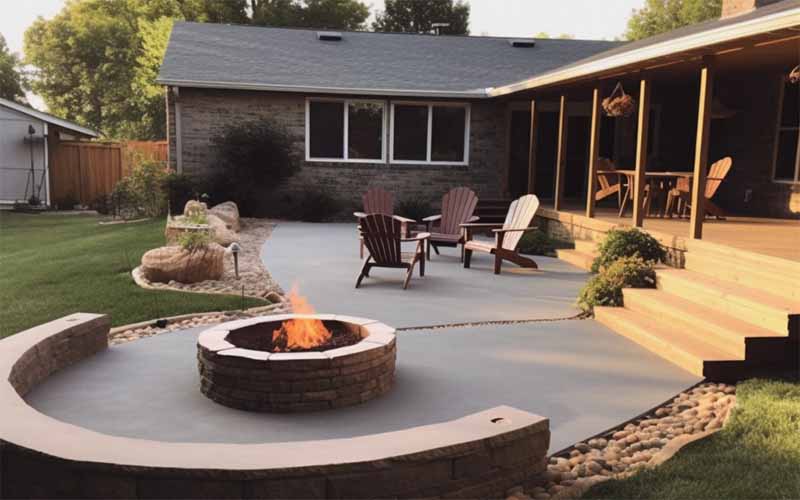Can You Build a Fire Pit on Concrete (Will Concrete Crack?)
Nothing beats the warmth and coziness of gathering around a fire pit with family and friends as the temperature drops.
However, if you’re considering building a fire pit on concrete, you may be concerned about whether the concrete will crack or become damaged over time.
In this article, I’ll explore the answer to this question and provide you with everything you need to know to safely build a fire pit on concrete.
Can You Build a Fire Pit on Concrete?
You can build a fire pit on concrete. However, it’s important to take certain precautions to prevent damage to the concrete.
Concrete is a durable and strong material that can crack or become damaged under extreme temperatures or pressure. Of course, there are many ways to fix cracked concrete patio, but it is better be safe than sorry.
Therefore, it’s important to follow some guidelines when building a fire pit on concrete to ensure the safety and longevity of both the concrete and the fire pit.
Let’s explore the best practices for building a fire pit on concrete.
1. Choose the Right Location
Select a location on your concrete patio or slab away from structures, trees, or other flammable materials.
2. Use Fire-Resistant Materials
Use fire-resistant materials such as firebricks, lava rock, or gravel to create a barrier between the fire and the concrete.
3. Avoid Direct Contact
Avoid placing the fire pit directly on the concrete. Use a fire pit pad or a metal fire pit ring to prevent direct contact between the fire and the concrete.
4. Adequate Drainage
Ensure the area around the fire pit has adequate drainage to prevent water from pooling on the concrete.
5. Monitor the Fire
Always monitor the fire when burning, and never leave it unattended.

Common Concerns and Solutions
Here’s a list of some common concerns about potential damage and possible solutions:
1. Heat Damage
Direct exposure to high heat can cause the concrete to crack or become damaged.
To prevent heat damage, use fire-resistant materials such as firebricks, lava rock, or gravel to create a barrier between the fire and the concrete.
Avoid placing the fire pit directly on the concrete, and use a fire pit pad or a metal fire pit ring to prevent direct contact between the fire and the concrete.
2. Water Damage
Concrete can be damaged by moisture or water, especially if it’s not properly sealed.
To prevent water damage, ensure the area around the fire pit has adequate drainage to prevent water pooling on the concrete.
Additionally, seal the concrete with a waterproof sealant to protect it from moisture or water.
3. Staining
Fire pits can leave unsightly stains on concrete if not properly maintained.
To prevent staining, regularly clean the fire pit and surrounding area to remove any ashes, soot, or debris. You can also use a protective cover for the fire pit when it’s not in use.
4. Uneven Surface
An uneven surface can cause the fire pit to wobble or tip over, which can be dangerous.
To ensure a stable surface, use a level tool to check the concrete surface where you plan to build the fire pit. If the surface is uneven, you may need to use a leveling compound to create a level base.
Alternatively, you can consider building a raised fire pit with a stable foundation. A raised fire pit will stabilize and prevent direct contact between the fire and the concrete surface.
5. Safety Concerns
A fire pit that isn’t properly constructed or monitored can pose a safety hazard to your property and family.
To ensure safety, always monitor the fire when burning and never leave it unattended.
Follow the guidelines for safe fire pit construction, including choosing a location away from structures, trees, or other flammable materials.
Also, use fire-resistant materials and adequate drainage.
Finally, check with your local fire department or building department for any regulations or permits needed for fire pit construction in your area.
Extra Tip: Smoke and Fumes
Smoke and fumes from the fire pit can be a nuisance to you and your neighbors.
To minimize smoke and fumes, use dry and seasoned firewood that burns efficiently with less smoke.
Avoid using wet or green wood, which produces more smoke and fumes. You can also consider using a smokeless fire pit designed to burn cleaner and more efficiently.
Additionally, choose a location for the fire pit that is not too close to your neighbor’s property to avoid causing any disturbance.
If you live in an area with strict regulations, check with your local fire department or building department for any restrictions on fire pit use.
Closing Thoughts
In conclusion, building a fire pit on concrete can be a great addition to your outdoor living space, but taking the necessary precautions to prevent damage to your concrete is important.
By following the tips and guidelines outlined in this article, you can safely build a fire pit on your concrete patio or slab and enjoy the warmth and ambiance of an outdoor fire all year round.
If you want a more straightforward solution, a fire pit table is a safe way to enjoy the fire. You can read more about safety tips for fire pit tables in our other piece of article.


